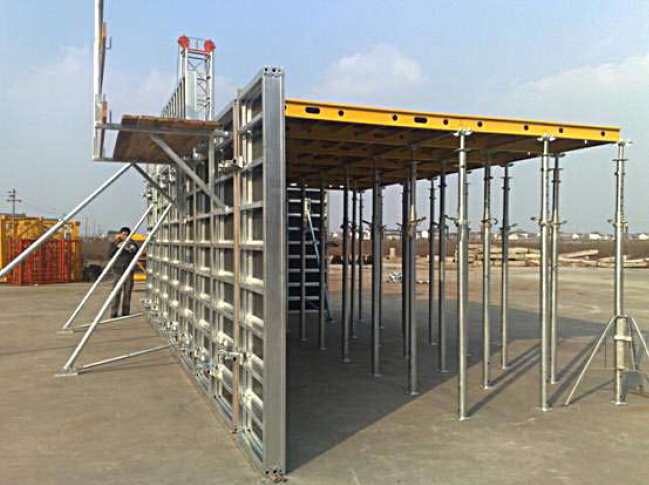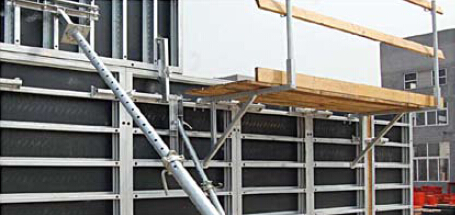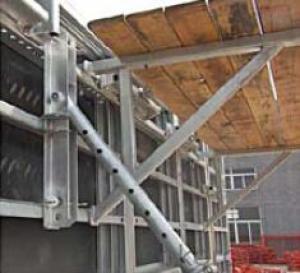Steel Frame Working Platformfor Formwork and Scaffolding system
- Loading Port:
- Tianjin
- Payment Terms:
- TT OR LC
- Min Order Qty:
- 50 m²
- Supply Capability:
- 1000 m²/month
OKorder Service Pledge
OKorder Financial Service
You Might Also Like
Steel-frame Formwork SF-140
Characteristics:
◆ Few parts for fast forming.
◆ Max. Concrete pressure: 80KN/m2.
◆ Hot-dip galvanized steel frame.
◆ The thickness of plywood is 18mm & the panel is 14cm.
◆ Compatibility with Hunnebeck Manto system due to similar edge profile.
System Details & Application:
◆ Neat joint and fast assembling with aligning panel clamp.
◆ Flexible panel arrangement and height extension.
◆ The selection of panels.
◆ Kinds of panel connectors.
◆ Corner clamp application.
◆ Length adjustment application.
◆ Height adjustment & aligning strut.
◆ Walkway bracket & platform.


- Q:Can steel formwork be used for high-rise construction projects?
- Indeed, high-rise construction projects can indeed utilize steel formwork. Renowned for its robustness and resilience, steel formwork is ideally suited for demanding tasks like high-rise construction. It furnishes exceptional steadiness and reinforcement to the concrete throughout the pouring and solidifying stages, guaranteeing the building's structural soundness. Moreover, steel formwork can be swiftly assembled and disassembled, making it highly efficient for constructing tall edifices that encompass multiple floors. Furthermore, its reusable characteristic facilitates long-term cost savings. In summary, steel formwork is an esteemed and widespread preference for high-rise construction endeavors.
- Q:Can steel formwork be used in areas with high moisture content?
- Yes, steel formwork can be used in areas with high moisture content. Steel is highly resistant to moisture, making it suitable for use in humid or wet environments. It is less likely to warp, rot, or deteriorate compared to other materials like wood. However, proper surface protection such as anti-corrosion coatings or galvanization may be required to ensure the longevity and performance of the steel formwork in high moisture conditions.
- Q:How does steel formwork impact the overall project management?
- The overall project management can be significantly influenced by steel formwork in various ways. First and foremost, the durability and longevity of steel formwork allow for multiple reuses throughout the project, reducing the need for frequent replacements and repairs and saving both time and money. Furthermore, the use of steel formwork ensures a high level of accuracy and precision, guaranteeing that the concrete structures are constructed according to the specified dimensions and specifications. This not only enhances the quality of the project but also reduces the chances of rework or corrective measures, thereby saving time and resources. In addition, steel formwork offers greater flexibility and versatility compared to traditional wooden formwork. It can be easily adjusted and modified to accommodate changes in design or unforeseen circumstances during the construction process. This adaptability enables project managers to quickly and efficiently make on-site adjustments, keeping the project on track and minimizing delays. Moreover, the installation and dismantling process of steel formwork is known for its speed. This allows for faster construction cycles, enabling project managers to meet tight deadlines and complete the project within the scheduled timeframe. The quicker turnaround time also improves project efficiency and reduces overall project costs. Lastly, steel formwork is considered a safer option compared to other formwork materials, providing a stable and secure platform for workers and minimizing the risk of accidents and injuries. By prioritizing worker safety, project managers can maintain a productive and efficient work environment. In conclusion, the utilization of steel formwork positively impacts overall project management by enhancing durability, accuracy, flexibility, speed, and safety. This leads to improved project outcomes, reduced costs, and enhanced efficiency, ultimately contributing to the successful completion of the project.
- Q:Can steel formwork be used for both interior and exterior concrete elements?
- Steel formwork is suitable for both interior and exterior concrete elements. Its versatility makes it applicable to different construction projects. Furthermore, steel formwork is known for its durability, strength, and ability to withstand the pressure exerted by wet concrete. It also provides exceptional dimensional accuracy and ensures smooth and uniform concrete surfaces. Whether constructing interior slabs, walls, or exterior foundations, columns, or beams, steel formwork is a dependable option for both interior and exterior concrete elements.
- Q:What are the different types of steel formwork?
- There are several types of steel formwork used in construction projects, including traditional steel formwork, modular steel formwork, and tunnel formwork. Traditional steel formwork involves the use of customized steel panels that are assembled on-site to create the desired formwork shape. Modular steel formwork consists of pre-made steel panels that can be easily fitted together to form various shapes and sizes. Tunnel formwork, on the other hand, is a specialized type of steel formwork used in tunnel construction, where large steel sections are assembled to create a continuous tunnel structure.
- Q:How does steel formwork handle extreme weather conditions?
- Steel formwork is highly resistant to extreme weather conditions. Unlike wooden formwork, steel formwork does not warp or expand due to changes in temperature or humidity. It can withstand intense heat, heavy rain, snow, and strong winds without losing its shape or structural integrity. This durability makes steel formwork a reliable choice for construction projects in areas prone to extreme weather conditions.
- Q:What are the common challenges faced during steel formwork removal?
- Steel formwork removal presents several common challenges. One of these is the difficulty in disassembling the formwork due to the tight connections and fasteners used in its construction. The rigid structure of steel formwork makes it challenging to remove without the appropriate tools and techniques. Another challenge is the weight of the steel formwork itself. Being a heavy material, steel makes the removal process physically demanding. Safe removal requires the use of proper lifting equipment and techniques to prevent worker injuries. Furthermore, corrosion poses a challenge during steel formwork removal. Moisture exposure over time can lead to rust and corrosion, making the formwork more difficult to dismantle. Regular inspections and proper maintenance can help identify and prevent corrosion, thereby reducing the challenges during removal. In addition, the presence of concrete residue complicates the removal process. Concrete can adhere to the formwork, making separation difficult. This may require additional tools or methods such as chipping or the use of release agents to facilitate the removal. Lastly, the coordination and timing of formwork removal can be challenging. Removing the formwork too early can compromise structural stability, while removing it too late can cause delays in subsequent construction activities. Proper planning and communication among the construction team are essential to ensure timely and sequential formwork removal. In conclusion, the challenges faced during steel formwork removal include tight connections and fasteners, the weight of the formwork, corrosion, concrete residue, and coordination and timing. Overcoming these challenges necessitates the use of proper tools, techniques, maintenance, and effective communication among the construction team.
- Q:What are the common cost-saving strategies when using steel formwork?
- Some common cost-saving strategies when using steel formwork include reusing the formwork for multiple projects, accurately measuring and cutting the formwork materials to minimize waste, properly maintaining and storing the formwork to prolong its lifespan, and utilizing innovative formwork systems that allow for faster installation and dismantling.
- Q:How does steel formwork handle different concrete admixtures?
- Steel formwork is a highly versatile and durable system that is capable of handling various concrete admixtures. Admixtures are added to concrete to enhance its properties, such as strength, workability, durability, and setting time. One of the key advantages of steel formwork is its ability to withstand the chemical reactions caused by different concrete admixtures. Steel is highly resistant to corrosion and can withstand the alkaline environment of concrete, as well as the potential chemical reactions caused by admixtures. Steel formwork can effectively handle admixtures like accelerators, retarders, plasticizers, and air-entraining agents, among others. Accelerators are used to speed up the setting and hardening process of concrete, while retarders are used to slow down the setting time. Steel formwork can accommodate the varying setting times caused by these admixtures, allowing for efficient construction processes. Plasticizers, also known as water-reducers, are commonly used to improve the workability and flow of concrete, making it easier to pour and shape. Steel formwork can easily handle the higher fluidity of concrete with plasticizers, ensuring that the concrete maintains its shape and does not leak or slump excessively. Another important admixture is air-entraining agents, which introduce microscopic air bubbles into the concrete. These air bubbles enhance the durability and freeze-thaw resistance of concrete. Steel formwork can handle the entrapped air and maintain the required consistency and structural integrity of the concrete. Furthermore, steel formwork can also handle other specialized admixtures such as corrosion inhibitors, shrinkage reducers, and waterproofing agents. These admixtures are used to address specific challenges associated with concrete construction, and steel formwork provides a reliable and stable platform for their successful implementation. In summary, steel formwork is a robust and adaptable system that can effectively handle various concrete admixtures. Its resistance to corrosion and stability make it an ideal choice for accommodating the chemical reactions and properties of different admixtures, resulting in high-quality and durable concrete structures.
- Q:Are there any specific safety guidelines for steel formwork installation?
- Steel formwork installation requires adherence to specific safety guidelines. The following key safety measures should be observed: 1. Training and Competency: All personnel involved in steel formwork installation must undergo proper training and possess the necessary skills. This includes knowledge of equipment, understanding of installation procedures, and awareness of potential hazards. 2. Personal Protective Equipment (PPE): Workers must wear appropriate PPE, including hard hats, safety glasses, gloves, and steel-toed boots. This is to protect against potential head, eye, hand, and foot injuries. 3. Inspection and Maintenance: Regular inspections should be conducted on the steel formwork and associated equipment to identify any defects or hazards. Immediate repairs or replacements should be carried out for damaged or faulty parts to ensure safety during installation. 4. Hazard Identification and Control: Before commencing installation, a comprehensive assessment of the work area must be performed to identify potential hazards, such as overhead power lines, uneven ground, or confined spaces. Adequate measures, like erecting barriers, using warning signs, or implementing fall protection systems, should be taken to control these hazards. 5. Manual Handling: Proper lifting techniques should be employed to prevent back injuries or strains. For heavy or awkward loads, the use of mechanical aids such as cranes or hoists should be considered. 6. Fall Protection: Due to the inherent risk of falls during steel formwork installation, especially when working at heights, the use of adequate fall protection systems, such as guardrails, safety nets, or personal fall arrest systems, is essential to prevent accidents and safeguard workers. 7. Communication and Coordination: Clear communication and coordination among the installation team are crucial for a safe installation process. Regular safety briefings, ensuring clear understanding of roles and responsibilities, and maintaining an open line of communication for reporting safety concerns are essential. It is important to note that these guidelines may vary depending on the specific project, local regulations, and industry standards. Therefore, it is advisable to consult with relevant authorities, such as the project engineer or site safety officer, to ensure compliance with all necessary safety requirements.
1. Manufacturer Overview |
|
|---|---|
| Location | |
| Year Established | |
| Annual Output Value | |
| Main Markets | |
| Company Certifications | |
2. Manufacturer Certificates |
|
|---|---|
| a) Certification Name | |
| Range | |
| Reference | |
| Validity Period | |
3. Manufacturer Capability |
|
|---|---|
| a)Trade Capacity | |
| Nearest Port | |
| Export Percentage | |
| No.of Employees in Trade Department | |
| Language Spoken: | |
| b)Factory Information | |
| Factory Size: | |
| No. of Production Lines | |
| Contract Manufacturing | |
| Product Price Range | |
Send your message to us
Steel Frame Working Platformfor Formwork and Scaffolding system
- Loading Port:
- Tianjin
- Payment Terms:
- TT OR LC
- Min Order Qty:
- 50 m²
- Supply Capability:
- 1000 m²/month
OKorder Service Pledge
OKorder Financial Service
Similar products
New products
Hot products
Related keywords






















